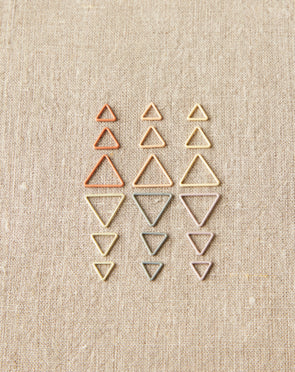How to Long Tail Cast On without Estimating Tail Length
Instructions
Here’s how to CO without having to estimate the tail length:

Step 1
Use two tails of yarn, either from

two separate balls of yarn, OR
a tail from the inside and a tail from the outside of a center-pull ball.

Step 2
Leave at least 3" on each tail, tie the ends together with a slip knot.


Step 3
Slide the slip knot onto your needle and tighten it up.


Step 4
Now separate the two working strands as if they were one long strand and work long-tail CO as usual.


Step 5
On left hand wrap yarn around finger and thumb (as seen in photo and video).

Step 6
With right needle, come under thumb loop of left hand.
Step 7
Then come over finger loop and draw a loop of yarn from the finger loop through thumb loop.
Step 8
Release, tighten up that stitch, and reposition fingers/hands for next cast-on stitch.
Step 9
When you have all stitches CO (do NOT count the initial slip knot), cut one of the working strands, leaving a tail that you can later work in.
Step 10
Begin knitting with the uncut strand of yarn and when you come to the other end of your CO, slide the slip knot off the needle and pull out the knot.
If you are casting on fewer stitches, check out the traditional method.


Comments
Wonderful!!! Have spent my knitting like casting on, not having enough wool, and casting on again.
I find it easier to wind gently around a needle half size larger than I will be using to knit, as many times around as stitches needed to cast on. I then add a slip knot at that point, slide that onto my working needle, and do the long tail cast on. I rarely have either too much or too little yarn left after my cast on.
Hi Peggy,
To keep the inside and outside strands from getting tangled, be sure to keep them separate as they come away from the ball. To do this, pull off a length of yarn from the outside of the ball and set it on one side (left if this will be the “long tail”) and pull out from the center on the other side, keeping the strands away from each other, except where you are working the CO. Start the CO and once you have used all the yarn from the outside of the ball, pick the ball up and unwind another length without letting it get crossed with the yarn coming from the center. This will keep them from winding around each other as they would if you just used both ends at the same time without separating them. Hope that helps!
I usually do this with two skeins of yarn. I think I’ve tried with one skein (inside/outside) but it got tangled. How do you keep it from getting tangled.
when casting on a great number of stitches, this is the way I do it! The only thing I don’t like about this method is another tail to weave in!!🙂
I don’t understand this technique— the video or the instructions .
I do not understand this part:
" …then fold in half to where you started winding the yarn round your needle."
Fold what in half? Huh?
Thanks.
My way of estimating yarn length is to half the number of stitches which have to be cast on, for example- if you have to CO 64 stitches, take your knitting needle and wrap it 32 times round your needle not too tightly, then fold in half to where you started winding the yarn round your needle. You can add a few more stitches to be sure
Make a slip knot and away you go, works for me every time 🤗
Hi Lynn, Glad you find it helpful! Check out the written instructions. Step 9 instructs you to cut one of the strands at the end of the cast on, then continue with your knitting. Enjoy!
Great tip, but do you continue using both ends of yarns
Or do,you cut one off eventually? Sorry to be stupid but it isn’t explained
I think the video left out the cutting of one of the live strands to know which one to start knitting with. Very helpful information, regardless.
Great information, I’d never be able to think of this on my own, in spite of much trial and error during my knitting days. (some 8 years ago).
Moltres gràcies per ajudar-nos amb les teves habilitats.
That is great information,and easy to understand! Thank you for sharing!
That is genius! Thank you so much for sharing this great tip!🧶I will do it this way now forever!
Brilliant! This will make a big difference in my knitting!!!
Wow! This is great…and rather easy to follow. Thanks for making my return-to-knitting so nice. I’ve been away from the craft for such a long time that I’ve managed to forget much of the beginning phases. Your instructions are such a boon for me. Again, big bunches of thanks.
This is great! I am facing a 200+ stitch cast on for a cowl.
Very complicated and makes no sense to me. Thank you anyway
Thank you so much for sharing this. I can’t tell you how many times I’ve ended up with a huge long tail or not enough to finish the cast on.
Leave a Comment